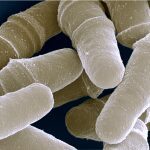Lien vers Pubmed [PMID] – 15530393
Curr. Biol. 2004 Nov;14(21):1924-8
The sexual locus mat1, in the fission yeast Schizosaccharomyces pombe, efficiently switches between the two mating types, P and M, by a process similar to gene conversion, using the silent mat2-P and mat3-M loci, respectively, as donors of the P and M genetic information . It has been proposed that an asymmetrically inherited, site- and strand-specific imprint at mat1 initiates the mating-type switching process . The molecular nature of the imprint is controversial; it was initially described as a double-strand break and then as a single-strand lesion or a strand-specific, alkali-labile modification . Here, we use E. coli DNA ligase in vitro to demonstrate that the imprint is a nick with no resection of nucleotides. By using ligation-mediated PCR, we show that the nick contains 3’OH and 5’OH unphosphorylated termini resistant to RNase treatments. This nonmutational mark on one of the DNA strands provides the first example of a novel type of imprint.

